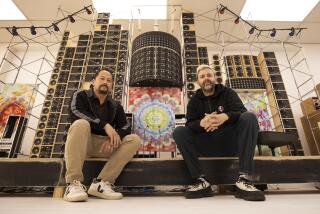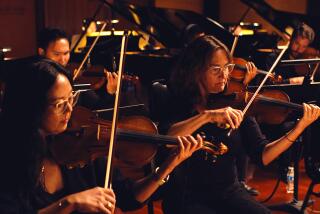Broadway’s in Basement at UCLA
Suppose, for some reason, that you have to know the words to that popular Civil War love song “Lorena.” Or you want to track down a favorite tune from one of the myriad 1940s musicals. Perhaps you need some unique vocal material for an audition. Where to go?
UCLA’s Schoenberg Hall houses a nationally important but relatively little-known and under-used research facility that provides the answer to musical questions. The UCLA Archive of Popular American Music, one of the largest such collections in the country, is available to students, researchers, historians, writers, actors, musicians and those who have a serious interest in the popular musical expression of American culture.
Shelves, Stacks and Cartons
In a 30-by-100-foot basement room filled to capacity with filing cabinets, shelves and multiple well-ordered stacks and cartons of as-yet uncatalogued material, the archive holds at least a million pieces of popular and semiclassical sheet music dating from the early 19th Century to the present. There are also orchestrations, song folios and thousands of recordings.
The collection evolved in typically Hollywood fashion, a story with elements of murder, show biz and buried treasure.
Back in the 1960s, Stanley Ring, who operated Ring’s Used Music Shop--a Hollywood musical landmark--was killed in a street shooting. Composer Meredith Willson, a longtime Ring customer, bought the store’s contents at auction and then donated them to UCLA in 1965, where they languished in closets and cupboards scattered around the campus. To the rescue came David Morton, UCLA music professor and former Ring customer, who agreed to take on the overwhelming task of sorting and indexing the Ring collection.
In the ensuing 20 years Morton has been able, with a maximum of energy and devotion, a minimum of funding and the occasional help of some UCLA work-study students, to build the collection, originally bought for $6,000, to its present prodigious size and inestimable value.
Over the years other collections have been obtained and added to the core archive that Morton now considers to be “fairly complete until 1950. The Ring collection began to dwindle after 1950,” he said, “since Ring only bought used, not new, material. From 1950 on it’s kind of a hit-or-miss affair, although we’re filling in all the time, and we do keep up with the latest show and film music.”
“What’s ironic,” he continued, “is that some of the sheet music I bought while I was growing up I traded to Mr. Ring for opera scores, and every once in a while as I catalogue material here at UCLA I’ll run across some of my music.”
Morton, a pianist and composer who has taught UCLA classes ranging from composition theory to popular music, explains his years of mostly unremunerated work on the archive this way: “I’ve done this as something I think is important to posterity. The history of any culture is represented in its popular music. High-art or classical music represents only about 10% of the population, and it’s generally not indicative of the culture itself.”
Morton’s filing system divides the collection into three major categories: film, stage and non-show music. Other subclassifications include concert art songs, foreign songs, orchestrations, anthologies, holidays and personalities.
Although the collection is housed in cramped quarters that seldom permit on-the-spot research, Morton fields written queries and telephone calls from all over the country. “The collection is not open to the public in the way that libraries are--the music is too fragile to be handled often,” he said. “But the material is here for qualified research people. Those who need the older type of music, and, on a limited basis are lacking full-time staff, we help as much as we can, within the archive itself.”
Many telephone calls are referrals from the Los Angeles Central Library, where the sheet music collection is limited. Other calls and requests come from people wanting information about lyricists, composers, artists, publishers and dates of publication. Some are looking for words and music from out-of-print songs, usually those of the ‘20s and ‘30s. Schools often need material for thematic programs. Many calls come from National Sheet Music Society members wanting to trade duplicate sheets. The archive has many duplicates, including at least 25 different editions of a popular ‘30s tune, “All Ashore.”
Singer-actress Lynne Levine, a UCLA graduate and part-time archive assistant, considers the collection an invaluable resource for Los Angeles in particular: “Show business people who need unique showcase material suited to their talents and personalities will find music here that’s just not available elsewhere.”
More to Read
The biggest entertainment stories
Get our big stories about Hollywood, film, television, music, arts, culture and more right in your inbox as soon as they publish.
You may occasionally receive promotional content from the Los Angeles Times.










